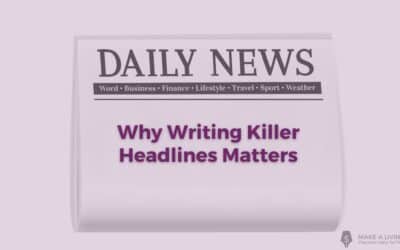
It could be because the type of story you pitched is one the magazine doesn’t accept — or does, but expects to get for free.
If you’re in this to get great-paying article assignments, you need to understand the types of articles that make editors cough up the big bucks.
This is particularly hard, I think, for writers who’ve been mostly posting on their own blogs, or writing for content mills. The parameters of what’s desirable there are radically different from what magazines want.
Here’s a look at seven types of articles that make editors want to turn down your idea:
1. I’m the expert
Often, budding writers who are former lawyers, accountants, insurance brokers, or some other type of professional have a history of contributing articles to their organization newsletter as a volunteer. When you show those clips and pitch more articles based on your expertise and pitch similar advice pieces, you may be disappointed to find publications expect them to be free.
To get paid to write articles, you have to position yourself as the writer, not the expert. You’ll be expected to go out and interview experts and report their points of view. This is a big shift, but one that will take you away from freebie articles to promote your profession and into the world of good-paying articles.
2. I have an agenda
Many of the story ideas I see when we review ideas in 4-Week Journalism School stem from something the writer wants to advocate for — say, that parents should encourage their children to journal.
If you have a topic about which you have formed a strong opinion, it will be hard to report an unbiased story in which you quote experts on both sides of an issue. You won’t talk to that expert who thinks lack of exercise is the biggest problem with our youth today and they should stow the notebook and go shoot some hoops.
Your story will end up lopsided and biased. If an editor even suspects you can’t be evenhanded with a story, they’re not going to give it a green light.
3. I have a HIDDEN agenda
Sometimes a writer has something they’re hot to promote — but they don’t disclose how they might personally benefit from promoting it.
For instance, I recently saw a travel-magazine pitch from a writer whose day job is with his country’s travel bureau, all about the advantages of coming to visit…his country! Pitching a story like this without disclosing who he works for is a conflict of interest. Obviously, this writer would have earned kudos from his boss and possibly even gotten a raise if he could stimulate more tourism business through this article, so the pitch was completely self-interested.
Trying to slip a piece like this by your editor is a great way to find yourself banned from writing for that publication ever again, once your deception comes to light. And trust me, it will.
4. I want to do an investigative expose´
You’ve discovered a thorny issue or wrongdoing that the public needs to know about and you’re all fired up to get that story told. Unfortunately, it is very difficult to get a piece like this assigned as a freelancer, especially if it’s your first pitch to a publication. You’ll have more luck with publications where you already have an established track record.
The reason is that investigative work tends to be very time-consuming and require a deep understanding of journalism ethics. When you make accusations, you have to be very sure of your facts, or your publication risks getting sued out of existence. An editor is unlikely to trust an untried writer to dive into something that is potentially legally actionable and could take months to report.
This is why most investigative work is done by staff writers, where the publication has enough staff to spare someone for a big block of time. I once did an investigative piece as a staffer that I researched on and off for nearly a year. At the end, we concluded that while I had found an intriguing case of small-time charity fraud and facts were well-reported, the story didn’t reveal enough useful information to our publication’s readers to be worth the large amount of editorial space required to tell the story. The piece never ran.
Trust me, as a freelance writer, you don’t want to go down this kind of sinkhole and end up not earning after a ton of work. Also, quite often the expose a writer wants to do has to do with an issue they’ve got a personal point of view and agenda on…so see #2 again on that problem.
5. My story makes your advertisers look bad
You’re in double-trouble if the perceived wrong you are on a mission to right is something that is committed by the advertisers of your target publication.
For instance, I recently heard from a writer who wanted to do an investigative piece and prove that the major drug companies are conspiring to keep the public from knowing about and using natural remedies. Her idea was to pitch this to a lifestyle magazine full of ads for aspirin, Viagra and other big-pharma products. In going over that scenario with me, she suddenly realized why this story idea was a non-starter.
Yes, there is a division between editorial and advertising at most reputable publications, and the ad department can’t tell the editors what to write…but the publication also does have to stay in business. You probably need to find another venue if you’d like to take potshots at the people who pay their bills.
6. I want to vent
Something happened in your life that made you frustrated or angry, and you’d like to tell the world about it. These make great first-person essays…and the problem is those rarely pay well. Most see the light of day as free letters to the editor.
The reason these don’t pay well is vent articles rarely provide practical, useful information to readers. Helpful info is at the heart of the vast majority of well-paid articles, so your vent tends to get a “pass” from the editor. The way to sell these is to angle it away from being a vent and turn it into a useful case study others can benefit from, as I did when my blog was declared a malicious website by Facebook. By pitching the useful-lessons angle, I was able to get an editor’s OK to make it part of my paid blog for Forbes.
7. I’ve noticed a news peg, but don’t have an angle
Often, magazines will tie a story in with an upcoming event — the running of the bulls in Pamplona, or the 20th anniversary of a prominent local business. These create a “news peg,” or timeliness element that’s good to have in an article pitch…the problem is, you won’t be the only writer who’s thought of it. So if you pitch, “I’d like to write about the anniversary of Martin Luther King’s ‘I have a dream’ speech,” you’re only halfway there.
What will you say that hasn’t been said before about this event or institution? Without something fresh, this is more like a pitch to write a school paper (“What MLK’s ‘I have a dream’ speech means to me”) than a magazine article.
Will you do a roundup on how many streets in your town are named after MLK? Interview a surviving colleague? Cover an event being held in honor of the day? Catch us up on where MLK’s children are now, because you have exclusive access to them for interviews?
A strong story angle combined with a news peg can work great to get you the sale, but the fact that an anniversary is happening won’t do it alone. Without a defined approach, these articles could also ramble all over and lack focus, so the editor tends to shy away.
What article ideas have you had trouble selling? Leave a comment and I’ll try to help you refine your idea.
P.S. Congrats to Amanda @SkilfulScribe, who won the free ticket to 4-Week J-School!










